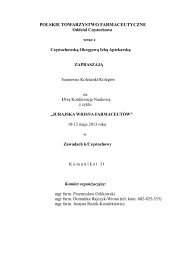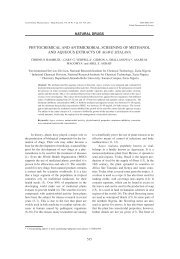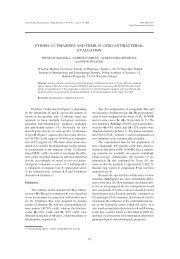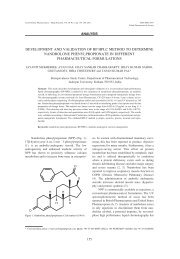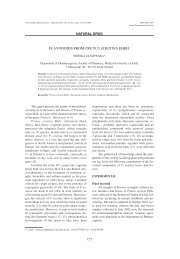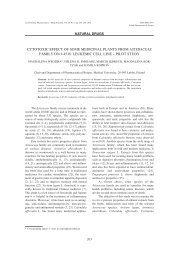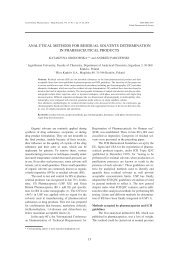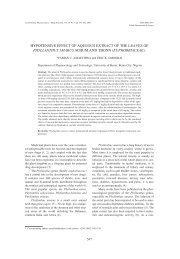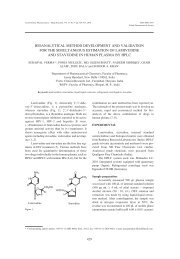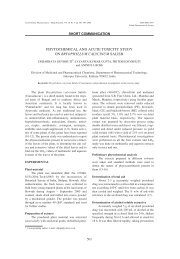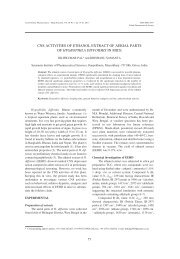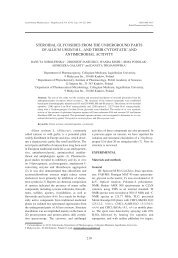first order derivative spectrophotometric and hplc methods for ...
first order derivative spectrophotometric and hplc methods for ...
first order derivative spectrophotometric and hplc methods for ...
Create successful ePaper yourself
Turn your PDF publications into a flip-book with our unique Google optimized e-Paper software.
392 BEATA STANISZ et al.<br />
spectrum. As a result, <strong>derivative</strong> UV spectrophotometry<br />
represents a more sensitive <strong>and</strong> selective<br />
tool in comparison with direct UV absorption measurements.<br />
EXPERIMENTAL<br />
Material, reagents <strong>and</strong> apparatus<br />
Moexipril hydrochloride was supplied by<br />
Schwarz Pharma AG (batch: 28057), each tablet<br />
contained 7.5 mg equivalent of moexipril<br />
hydrochloride (Cardiotensin 7.5).<br />
Methanol <strong>and</strong> acetonitrile were of HPLC grade<br />
(Merck KGaA, Darmstadt, Germany). Potassium<br />
phosphate monobasic was purchased from POCh<br />
S.A., Gliwice, Pol<strong>and</strong>. All other chemicals were of<br />
analytical reagent grade. Water used was freshly<br />
bidistilled.<br />
Spectrophotometric measurements were per<strong>for</strong>med<br />
on a Perkin-Elmer Lambda-6 spectrophotometer<br />
equipped with UV WinLab Version 2.70.01<br />
software. The UV spectra of reference <strong>and</strong> sample<br />
solutions were recorded in 1 cm quartz cells at a<br />
scan speed of 240 nm/min, response time 0.5 s <strong>and</strong><br />
fixed slit width of 3 nm. The concentrations of<br />
MOXL in its solutions in methanol were determined<br />
within wavelength range of 210ñ400 nm.<br />
For HPLC assay a Shimadzu liquid chromatograph<br />
equipped in: Rheodyne 7125 injector with a<br />
fixed loop of 25 µL capability, UV-VIS SPD-6AV<br />
detector, LC-6A pump <strong>and</strong> C-R6A chromatopac<br />
integrator was used.<br />
High per<strong>for</strong>mance liquid chromatography was<br />
per<strong>for</strong>med on a RP-Hypersil MOS 100 C8 (size 10<br />
µm, 250 mm × 4 mm I.D., Merck) column. The<br />
detector wavelength was set at 210 nm <strong>and</strong> mobile<br />
phase was pumped isocratically at a flow rate of 1.1<br />
mL/min. The injection volume was 20 µL. All determinations<br />
were per<strong>for</strong>med at ambient temperature.<br />
Preparation of st<strong>and</strong>ard solutions<br />
Spectrophotometric method: a st<strong>and</strong>ard solution<br />
(0.0012%) of MOXL was prepared by dissolving<br />
an appropriate amount of MOXL in methanol.<br />
HPLC method: a st<strong>and</strong>ard solution (0.04%) of<br />
MOXL was prepared by dissolving an appropriate<br />
amount of MOXL in methanol.<br />
Stored at 6 O C in the dark, st<strong>and</strong>ard solutions<br />
were stable during the period of study.<br />
Analysis of tablets<br />
Twenty tablets (Cardiotensin 7.5) were accurately<br />
weighed <strong>and</strong> powdered in a mortar. An amount<br />
equivalent to one tablet (7.5 mg of MOXL) was<br />
weighed <strong>and</strong> put with addition of 25.0 mL of methanol<br />
into 50 mL volumetric flask. The prepared mixture<br />
was sonicated <strong>for</strong> 15 min <strong>and</strong> filtered (solution A).<br />
Spectrophotometric method: 1.0 mL of solution<br />
A was diluted to 25.0 mL with methanol (solution<br />
A 1 ). The UV spectra D 1 (<strong>first</strong> <strong>order</strong> <strong>derivative</strong><br />
spectra) were recorded against methanol.<br />
HPLC method (reference method): mixture of<br />
1.0 mL of the solution A <strong>and</strong> 1.0 mL of internal<br />
st<strong>and</strong>ard (I.S.) ñ xylomethazoline hydrochloride<br />
(solution R) was analyzed by HPLC. Samples (20<br />
µL) to be analyzed were injected into the HPLC column<br />
<strong>and</strong> the emerging signals were recorded.<br />
Preparation of model mixtures <strong>for</strong> evaluation of<br />
<strong>methods</strong>í accuracy<br />
Model mixtures were prepared using<br />
Cardiotensin 7.5 tablets.<br />
Ten tablets of Cardiotensin 7.5 were grounded<br />
in a mortar with addition of: 25 mg of MOXL<br />
(Model mixture I), 50 mg of MOXL (Model mixture<br />
II) <strong>and</strong> 75 mg of MOXL (Model mixture III).<br />
Each mixture was grounded with a h<strong>and</strong> pistle<br />
<strong>for</strong> 20 min. The recovery was defined as percentage<br />
of the determined concentration of the constituent<br />
under examination with respect to the weighed<br />
amount.<br />
Preparation of mobile phase<br />
The mobile phase used in HPLC method was<br />
aqueous phosphate buffer at pH 2.0 (0.001 mol/L)<br />
<strong>and</strong> acetonitrile (1:1, v/v). The preparation of the<br />
<strong>for</strong>mer included: the dissolution of 0.0681 g of<br />
KH 2 PO 4 (M = 136.09 g/mol) in 400 mL of water in<br />
500 mL volumetric flask, the adjustment to the<br />
desired pH value using 80% orthophosphoric acid<br />
<strong>and</strong> final filling up the volume with water. The prepared<br />
mobile phase was filtered <strong>and</strong> degassed prior<br />
to use.<br />
Procedure <strong>for</strong> MOXL kinetic study<br />
Exactly weighed amounts of MOXL (0.0100 g)<br />
in opened, 5 mL glass vials were used <strong>for</strong> the determination<br />
of stability in the presence of relative<br />
humidity RH = 76.4%. The samples were stored in<br />
dessicator in an automatically controlled heat chamber<br />
at 363 K. After fixed time intervals, the samples<br />
of the investigated material were removed from the<br />
heat chamber, quantitatively transferred into 25 mL<br />
measuring flasks <strong>and</strong> dissolved up to volume with<br />
methanol (solution S).<br />
Spectrophotometric method: 0.5 mL of the<br />
solution S was diluted to 25.0 mL with methanol.<br />
UV spectra D 1 were recorded against methanol.



